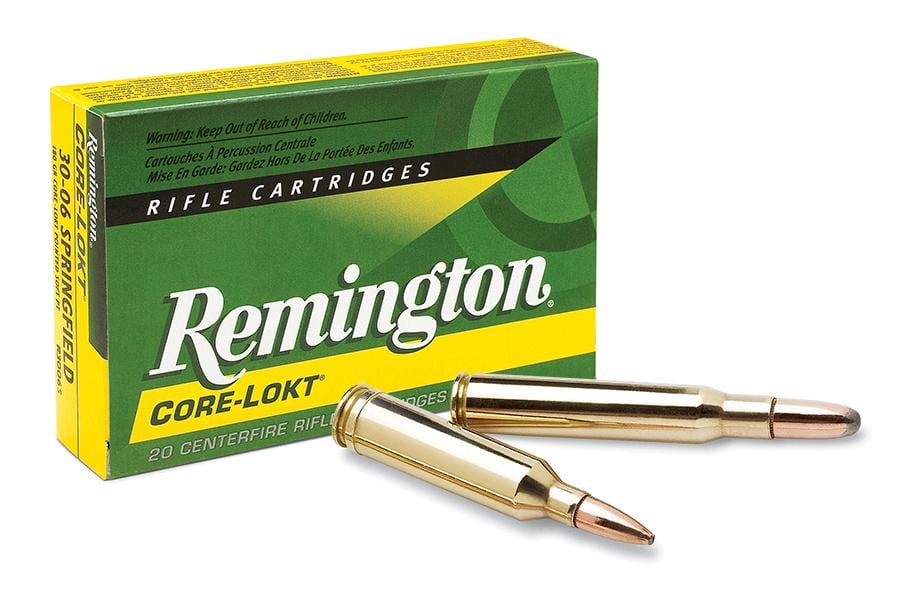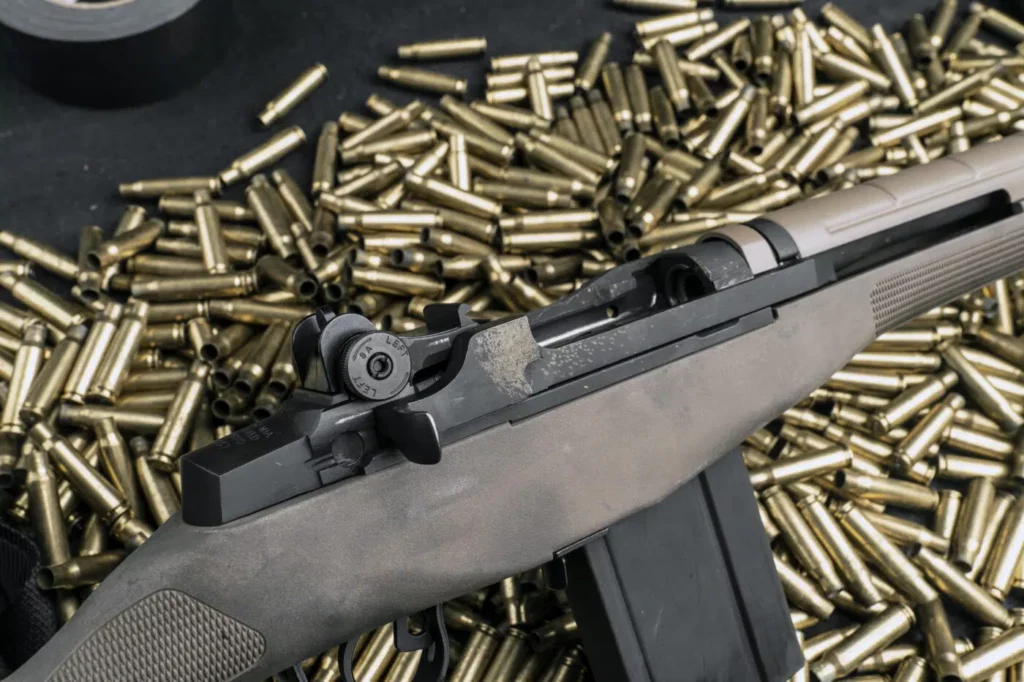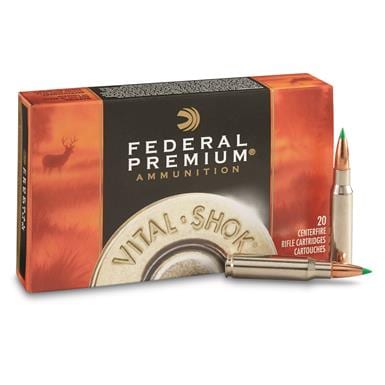With so many different options available, choosing the best ammunition to feed your firearm can feel a bit confusing and overwhelming at times. That is especially true for M1A rifle owners as the powerful, semi-automatic rifle is capable of excellent performance that can be enhanced even further with the right type of ammo.
The difference in rifle performance between ammo the gun likes and ammo it doesn’t like can be quite notable. This isn’t to say that an M1A rifle is only a good firearm when paired with the right ammo. It just means that ammo selection is worth paying attention to squeeze as much performance as possible from your rifle.
Scroll down to learn more and to see the best M1A ammunition options available today.
At a Glance: Our Top Picks for Ammo For M1a
Comparison of the Best Ammo For M1A
| IMAGE | PRODUCT | |
|---|---|---|
Our Top Pick  |
| View Latest Price → |
 |
| View Latest Price → |
What to Watch For When Buying Ammo For Your M1A
There are a lot of different factors that go into finding the best ammo for your M1A. There are also a ton of different brands and types of M1A ammo on the shelves. It can all get a little confusing when you aren’t exactly sure which kind to buy.
One important thing to remember is that no M1A ammo you buy is going to go to waste. The M1A will happily chew through any compatible ammo you feed it. The following information will help you narrow down your M1A ammunition buying options.
This Section Written By: Brian Belko
Expert Author

Brian is an experienced freelance writer and technical writer who has previously written for publications such as Wide Open Spaces, Bigfoot Gun Belts, Alien Gear Holsters, and Kampgrounds of America. He brings both a passion for writing and a love of the outdoors to his published content.
Aside from writing and the outdoors, Brian enjoys gardening, being a co-host on The Nostalgia Blast Podcast, and learning to code.
Testing 1, 2, 3
There is no information about particular ammo on the box or the manufacturer’s website that will tell you more than actually shooting that ammo from your M1A. In other words, the best way to figure out which brand and type of ammo work best for your M1A and your needs is to buy as many different kinds as you can and shoot them. Ideally, you’d shoot each type in similar conditions. The results of these shooting sessions will help you zero in on the type of ammo that provides the results you want to see from your M1A. Just remember that the M1A was not designed as a precision rifle so don’t expect consistent sub-MOA groups with even the best ammo.

Considering Your Needs
One helpful thing to do before heading to the gun store or the internet for ammo is to take a few minutes to really figure out what you want to accomplish with your M1A rifle. This might sound obvious, but that can be easy to forget in the excitement of a new rifle. Do you want to hunt tough game like hogs? Do you want an all-around ranch rifle that can be accurate at various ranges? Answers to questions like that will go a long way towards making your ammo choices clear once you are at the store or on your favorite ammo website.
Is Reloading The Way?
Reloading ammo is the process of creating custom ammo using brass, gunpowder, primers, and bullets. Reloading is a common way to create highly specialized ammo that is ideal for a specific rifle or for extreme accuracy. While it is possible to reload M1A ammo, it isn’t really necessary especially if you don’t already have all of the necessary equipment. Generally, reloading M1A ammo isn’t going to offer enough of a benefit over factory ammo to make it worth it.
Review of Best Ammo for the M1A
The following list consists of commercially produced new 7.62x51mm/.308 caliber rounds that are our recommendations for your M1A rifle. These cartridges meet all previously mentioned requirements and provide with the ability to stockpile the best loadings for the broadest spectrum and scenarios using 7.62x51mm NATO and commercial .308 Winchester ammo.
Best Overall
Federal Premium Vital-Shok Nosler Partition Centerfire Rifle Cartridges – .308 Winchester – 150 Grain

We may earn commission from purchases made from our links, at no additional cost to you
Major ammunition companies like Federal manufacture many types and ammo calibers divided into a number of production lines each designed for different purposes.
For hunters and medium to large game shooting, Federal Ammunition has introduced several line ammo products to the market. The popular Vital-Shok lineup in .308 Winchester is an excellent hunting option since it is loaded with some of the world’s finest big game bullets, such as latest offerings from Nosler.
The legendary Nosler Partition bullets for .308 Win are available in 150 and 180-grain bullet weights, efficiently covering the most North American game. The load using Partition 180-grain bullets achieves a muzzle velocity of 2,570 fps, whereas loads topped with 150-grain bullets reach 2,840 fps.
The hard-hitting Federal Vital Shok 308 Win. Partition bullets have a fully tapered jacket that ruptures instantly at the thin jacket mouth. The partitioned copper jacket allows the upper half of the bullet to mushroom, while the bottom half remains intact.
For some people, it can be inadequate due to the fact that the Vital-Shok Partition does not leave a big exit hole or even it can even lodge under the hide on the opposite side.
The nickel plated .308 Winchester case uses boxer-type, non-corrosive primers and can be reloaded.
Bottom Line
From the entire line of Federal ammunition, we have singled out the premium Vital Shok series in .308 Winchester as your best option for medium to large game animals and a perfect combo of accuracy and lethality.
Nosler’s Integral Partition bullet jacket uniformly shoots out at high or low velocities, utilizing the expanded mushroom and retaining the rear lead alloy core for deep penetration.
Pros
Core Material: Lead
Jacket Material: Copper
Case Type: Nickel Plated
Bullet Weight is 150 grains
Bullet Type is Nosler Partition
Primer Type: Boxer, reloadable
Muzzle Energy: 2,686 Foot Pounds
Muzzle Velocity: 2,840 Feet Per Second
The Upper Half of the Bullet Mushrooms
Base Remains Intact to Hammer the Bullet Home
Cons
Not Cheap
Does Not Leave a Big Exit Hole
Runner-up
Remington Core-Lokt Centerfire Rifle Ammo

We may earn commission from purchases made from our links, at no additional cost to you
Next, the American classic, Remington offers its original controlled-expansion bullet design in .308 Winchester, dubbed the Core-Lokt. The Remington Arms Express ammunition line, also known as “Green-box”, has loads that successfully meet market demand for more than six decades, primarily with hunting ammunition in a variety of caliber choices.
Remington Express Core-Lokt ammo with code R308W1 for .308 Winchester is loaded with 150 grain pointed soft point bullets that blend the expansion capabilities of a traditional soft point bullet with the more extended range performance capabilities of the spitzer-shaped bullet.
These effective PSP hunting bullets provide a perfectly controlled expansion and high weight retention after impact, due to the progressively tapered copper jacket which is locked to a solid lead core.
Another highlight of the Remington Express .308 Winchester Core-Lokt PSP round is its sleek nose profile for a high ballistic coefficient and horizontal trajectory at long ranges.
This Remington Core-Lokt 150 gr. load is launched from the M1A rifle at a muzzle velocity of 2,820 feet per second with a muzzle energy of 2,648-foot-pounds, making it an excellent round for deer-sized game hunting.
The reloadable cases are made of premium brass and feature non-corrosive boxer primers.
Bottom Line
The Core-Lokt series of ammo is designed with the hunter in mind, particularly for hunting medium to the large-sized game. While proven as big game hunting ammunition, the Remington Express .308 Winchester ammo is less expensive than its counterparts.
Pros
Reloadable
Boxer Primed
Non-Corrosive
Premium Brass Cases
Muzzle Velocity 2,820 fps
Muzzle Energy 2,648 ft./lbs
150 grains Soft Point Projectile
Bullet Type is Core-Lokt Pointed Soft Point
Controlled Expansion and High Weight Retention
Cons
Quality control could be better
3. Federal – Lake City 7.62x51mm Nato 149gr Xm80 FMJ Ammo Can

We may earn commission from purchases made from our links, at no additional cost to you
This bulk of affordable 7.62x51mm NATO ammunition comes from the Lake City Army Ammunition Plant (LCAAP), a U.S. Government-Owned, Contractor-Operated facility, or GOCO for short.
Even though Lake City Ammunition has been loaded to exact NATO specifications, some production batches do not meet all military specifications and they may have very slight, (typically cosmetic), imperfections. This ammo, marked with an “XM” lot designation, comes packaged in a plastic MTM ammo can with a rubber seal for easy carry to the range and for protection during storage.
Bulk-packed Federal XM80 7.62x51mm NATO features 149-grain copper-plated, full metal jacket bullets. Since this Federal Lake City 7.62 ammo is topped with steel core magnetic bullets, you wouldn’t be allowed to use them at indoor ranges.
The boxer-primed ammo is non-corrosive and has a reloadable brass case that can be reloaded up to seven times.
The ammo also offers a muzzle velocity of over 2,700 feet per second, with a muzzle energy of 2,485 ft. lb.
The ammunition plant at Lake City is related to Federal, so their case is head stamped with the Federal symbol and date of manufacture.
Bottom Line
Federal Lake City Mil-Spec ammunition is perfect for economic plinking and training at the open ranges, as well as long distance target shooting. As this cartridge uses the U.S. military’s standard-issue 7.62×51 (.308) “Ball”, FMJ bullet, it’s not suitable for hunting.
Pros
Boxer-Primed Case
Non-Corrosive Primers
Bullet Weight 149 grains
Muzzle Velocity 2,735 fps
Muzzle Energy 2,485 ft. lbs
Reloadable, Brass-Cased Ammo
Bullet type is Full Metal Jacket (FMJ)
Cons
May Have Some Dark Coloring on Case
Bi-Metal Jacketed Bullets do Attract Magnets
4. Winchester USA Rifle Ammunition

We may earn commission from purchases made from our links, at no additional cost to you
Winchester USA ammunition is the ideal choice for training or extended sessions at the range without barrel leading.
The 7.62x51mm NATO ammunition with Winchester item number Q3130 is topped with a 147-grain full metal jacket bullet that will not expand on impact. With something less than a .308Win muzzle velocity (2,750 fps vs 2,800 fps), it’s the perfect round for semi-auto firearms, such as your M1A or AR-10.
This Winchester USA ammunition, known as “White Box”, uses typical lead core projectiles with copper-plated steel jackets that prevent against barrel leading and provide an acceptable level of accuracy for plinking.
While this cheap Winchester 7.62x51mm ammo lacks the consistency, it is definitely not target ammo, but it is a fantastic practice round for shooters of all skill levels.
Exact military 7.62x51mm Winchester ammo is packed into reloadable brass cases that are boxer primed and non-corrosive.
Bottom Line
The 7.62x51mm NATO ammo with manufacturer number Q3130 is made to military standards, which means it features new reloadable brass cases and noncorrosive boxer primers.
Pros
No Barrel Leading
Muzzle Velocity: 2,750 fps
Caliber: 7.62x51mm NATO
Muzzle Energy: 2,468 ft./lbs
Noncorrosive Boxer Primers
Best for Targets, Training or Plinking
Bullet: 147-Gr. Lead-Core Full Metal Jacket
New-Manufacture Reloadable Brass Cases
Cons
Inconsistent Accuracy
Issues With Their Quality Control
5. Federal American Eagle Tactical Rifle Ammunition

We may earn commission from purchases made from our links, at no additional cost to you
For budget conscious customers, Federal manufactures American Eagle brand ammunition designed specifically for target shooting, training, and practice. Federal American Eagle Tactical ammo has reasonable performance for short to medium range plinking but is not as accurate as Federal high-grade competition offerings.
Though inexpensive target ammo, American Eagle Tactical Rifle Ammunition for your 7.62 x 51 M1A is loaded to military specifications for reliable and consistent functioning.
This Federal 7.62x51mm NATO Mil-Spec 149 Grain FMJ ammo offers a muzzle velocity of 2,750 feet per second and muzzle energy of 2,437 ft./lbs.
While the AE Tactical loads are great all-around FMJ cartridges, they feature a 149 gr. bullet with a metallic core that is attracted to magnets so won’t be appropriate for indoor ranges.
Since the Federal XM80CL ammo is non-corrosive and has a non-corrosive boxer primer, it is great for high volume shooters.
Bottom Line
The American Eagle XM80CL cartridge is the exact same round that was used in the M-14 and M-60 machine guns and you can now use it in your favorite M1A, any Sporter rifle, or other firearm chambered for .308 Winchester with no detrimental effects.
Pros
Reloadable
Brass Cases
149 Grain FMJ bullet
Muzzle Energy: 2,437 Ft./Lbs
Integrated Full-Length Sweat-Guard
An Affordable Option for the Target Board
7.62x51mm NATO (Safe for Use in .308 Winchester Chambers)
Cons
Accuracy is Not as Good as Federal’s Premium Loads
The Steel Core Cartridge it is Not Allowed for Most Indoor Ranges
M1A Ammo Considerations – Aspects to Keep in Mind
Unlike a service select-fire M14, the M1A is a semi-automatic-only version, built for sport-shooting and hunting. If the basic purpose for your M1A is not recreational shooting and plinking, then the ammo type and quality are definitely factors that can make a difference regarding accuracy in the longevity of your firearm and your entire shooting experience.
The Springfield Armory M1A is designed to shoot standard factory .308 Winchester or 7.62×51 NATO ammunition, since the two types are essentially the same. In fact, there are very small differences, so 7.62×51 and .308Win are not quite the same things.
Size
Shoulder to shoulder, the new sporting cartridge, the .308 Winchester, is nothing more than the future NATO 7.62x51mm military round. Featuring almost identical physical dimensions, the .308 and 7.62×51 are interchangeable, whereas both cartridges use an actual bullet diameter of .308 inches (7.82mm). The difference between them is inside the cartridges and refers to the case wall’s thickness and powder volume.

Another more theoretical issue can often be found on the web and refers to a different specification for cartridge primers. Unlike harder military ammo primers, the civilian ammunition utilizes primers that are more sensitive with an increased risk of primer detonation when the bolt slams forward. However, this is a very remote possibility. If you have barrel discipline when loading the rifle, then all is well.
Since the military rifles for 7.62x51mm NATO are designed to provide reliable feeding and operation by using ammo made all over the world, they usually have longer chamber headspace. This is the distance from the face of the bolt to a point on the chamber, which stops forward motion of the cartridge. For the 7.62x51mm NATO it is between 1.6355 and 1.6405 inches and for the sporting .308 ammunition chamber, the headspace is between 1.630 and 1.6340 inches.
While the Sporting Arms and Ammunition Manufacturers’ Institute (SAAMI) does not consider it unsafe to fire the .308 ammo in weapons chambered for the NATO cartridge, to keep yourself ultra-safe, you should fire only 7.62x51m NATO in 7.62 chambered firearms and .308 Winchester in .308 rifles.
Casing
While both cartridges have similar exterior dimensions, thicker walls mean less powder capacity and lower pressure and velocity. Since the 7.62×51 round has thicker case walls than .308 Winchester cases, the commercial .308 brass can take more propellant, enabling them to be loaded to higher pressures than the military 7.62×51mm NATO.

Commercial hunting ammo can be loaded up to 62,000psi (427 MPa), whereas the 7.62 NATO rounds are loaded to a maximum average pressure of 50,000psi (344 MPa) and are proof-tested at 67,000psi (462 MPa).
Grain
A grain is an extremely small unit of measurement for mass. In the firearms niche, the grain (abbreviated “gr.”) is used to measure bullet weight, and the propellant or gunpowder. Practically, it means the larger the grain, the heavier the bullet is.

While the bullets (projectiles) can weigh anywhere between 15 grains for the lightest calibers (17 HMR bullets) all the way up to 750 grains (.50 BMG), the most common type, .308 loads range from 147 to 180 grains.
While general advice is to avoid steel-cased ammo in a semi-automatic M1A, the uniform bullet weight is not so strict, but you have to stay within the golden middle. It means you should stay under 180 gr. and not use anything smaller than 147 gr., or 168 gr. when shooting past 600 yards.
Purpose
As for the scope or any other gun accessory selection, the first thing to do before making a decision is to determine the purpose for your ammo.
Choosing the right .308/7.62mm bullet weight depends on your intended use of M1A, but as rough guidelines, we break it down for you.
For casual plinking, you can use whatever bullet weight you want, with a focus on small price and proper functioning in your M1A. However, shooting for maximum accuracy and heavier hunting, the .308 bullets may be a better solution since they are less susceptible to being blown off course by the wind. Since bullets that are too heavy are more affected by gravity, projectiles of 168 grain are recommended for best accuracy in long-range shooting.
Cartridges for deer hunting purposes also demand the heavy 168-grain bullets, but a larger 175-grainer is better for bigger game, such as moose. Rounds heavier than 175 gr. will damage your M1A operating rod.

Besides weight, the bullet construction is very important in hunting, so many hunters also recommend hollow point and soft point rounds because they can cause quick and humane kills.
On the other hand, some shooters don’t advise using soft-tipped bullets, mostly because they do not always feed reliably from the magazine. The second reason is the soft bullet’s parts that end up in the rifle’s inner workings, and can then block the whole weapon.
For target shooting, you will probably want to stick to using bullets that are a standard full metal jacket (FMJ), or “ballistic tip” type, cartridges topped with 168-grain bullets manufactured by a match grade ammo company.
Some tracer and armor piercing ammunition produced in NATO specs can also be used. However, you should avoid using frangible loadings and any ammo type labeled “light magnum.”
Our final advice, though not as accurate as commercial ammo, is the military FMJ as the cheapest, best deal so you can keep a surplus of military ball ammo, though you should avoid using the surplus stuff labeled “loose” or “bulk”.
Conclusion
Even though the M1A is the latest gun in the world that is attributed to have “finicky” ammo, it should be treated as a mechanical system that relies on quality ammunition above all other considerations.
With that in mind, you should not use cartridges that are dirty, wet, corroded, bent, or damaged. Additionally, you should not oil or spray aerosol-type lubricants or cleaners onto ammunition.
Besides full metal jacket military ammunition, loads with hollow point or ballistic tip types of bullets work well in M1A rifles and will be suitable for relatively short-range shooting. However, for the best accuracy and ultimate real-world practice, you will probably want to stick with some of the match grade target rounds for the M1A.


